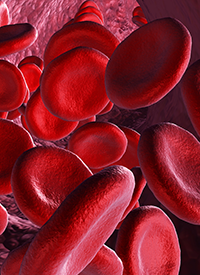News
Article
SRSF2 Mutations Lead to Lessened Frequency of Polycythemia in Preclinical MPN Models
Author(s):
The presence of mutated SRSF2 in knock-in mouse models of JAK2 V617F–driven myeloproliferative neoplasms reduced the rate of polycythemia and hampered hematopoietic progenitor functions.
SRSF2 Mutations in Preclinical MPN
Image Credit: ©yodiyim
stock.adobe.com

The presence of mutated SRSF2 in knock-in mouse models of JAK2 V617F–driven myeloproliferative neoplasms (MPNs) reduced the rate of polycythemia and hampered hematopoietic progenitor functions, according to findings from a preclinical study published in Blood Cancer Journal.
Findings from the study demonstrated that coexpression of mutant SRSF2 P95H decreased red blood cell (RBC), neutrophil, and platelet counts, as well as attenuated splenomegaly in JAK2 V617F-positive mice. Notably, bone marrow fibrosis was not induced in JAK2 V617F-positive mice. Coexpression of SRSF2 P95H was also found to reduce the competitiveness of JAK2 V617F–mutated hematopoietic stem/progenitor cells.
Additionally, RBC, hemoglobin, and hematocrit levels were significantly reduced in the bone marrow of JAK2 V617F–positive mice that displayed enforced expression of S100A9. Mutated SRSF2 P95H decreased TGF-β levels and increased S100A8 and S100A9 expression in JAK2 V617F–positive mice.
“We demonstrated that SRSF2 P95H mutant reduces polycythemia and impairs competitiveness of JAK2 V617F–mutant hematopoietic stem/progenitor cells but does not promote the development of bone marrow fibrosis inJAK2 V617F-induced MPN,” lead study author Yue Yang, MD, of the Department of Biochemistry and Molecular Genetics at the University of Virginia School of Medicine in Charlottesville, and coinvestigators wrote.
To conduct their study, investigators created JAK2 V617F knock-in, SRSF2 P95H knock-in, and Mx1Cre transgenic mouse models, all on a C57BL/6 background. Intraperitoneal injection of 3 doses of polyinosine-polycytosine 300 μg were given at 4 weeks after birth in order to induce Mx1Cre expression. Wild-type C57BL/6 and UBC-GFP mice were acquired from an outside laboratory.
To create non-competitive bone marrow transplantation assays, 1 x 106 bone marrow cells were taken from the mice in each of the 4 groups (control of wild-type or Mx1Cre; SRSF2 P95H-positive; JAK2 V617F-positive; and SRSF2 P95H/JAK2 V617F-positive) and transplanted into lethally irradiated C57BL/6 mice. Polyinosine-polycytosine was administered to the recipient mice at a dose of 300 μg 3 times at 4 weeks following transplantation.
Competitive transplantation assays were created by mixing bone marrow cells from uninduced JAK2 V617F-positive/GFP-positive or SRSF2 P95H/JAK2 V617F-positive/GFP-positive were mixed with wild-type competitor bone marrow cells at a 1:1 ratio and transplanted into wild-type C57BL/6. Recipient mice received 3 doses of polyinosine-polycytosine 300 μg at 4 weeks post transplantation.
To create colony-forming assays, investigators plated 2 X 104 mouse bone marrow cells in cytokine-containing complete methylcellulose medium. After 1 week, burst forming units-erythroid and granulocyte-macrophage colony-forming units were tallied. Spleen cells at a quantity of 1 x 105 were plated in MethoCult M3234 medium without cytokine to detect epo-independent colony-forming units-erythroid.
Epo-independent colony-forming units-erythroid were stained with benzidine solution and counted 2 days afterwards. Colony-forming units-megakaryocytes were determined by plating 1 x 105 bone marrow cells in collagen-based MegaCult medium with Tpo, IL-3, IL-6, and IL-11. Colony-forming units-megakaryocytes were scored at day 8.
S100A8 or S100A9 overexpression’s effect on granulocyte-macrophage colony-forming units and burst forming units-erythroid formation of JAK2 V617F-positive bone marrow, cells lineage-negative cells were isolated from the bone marrow. Puromycin 2.5 μg/mL administered for 48 hours was used to select infected cells and 2.5 × 103 lineage-negative cells were plated in duplicates in cytokine-supplemented complete methylcellulose medium.
Study authors analyzed the mice models using flow cytometry and real-time quantitative PCR. Additionally, the TGF-β1 ELISA kit was used to determine TGF-β1 serum levels.
Further findings revealed that mice with heterozygous JAK2 V617F displayed polycythemia vera with increased white blood cell, neutrophil, platelet, RBC, hemoglobin, and hematocrit counts in peripheral blood compared with control mice. Those with heterozygous SRSF2 P95H experienced decreased hemoglobin with increased mean corpuscular volume vs the control group. SRSF2 P95H/JAK2 V617F-positive mice had significantly decreased white blood cell, neutrophil, platelet, RBC, hemoglobin, and hematocrit levels vs JAK2 V617F–positive mice. Concurrent expression of JAK2 V617F and SRSF2 P95H mutations resulted in higher mean corpuscular volume values and reduced spleen size and weight vs JAK2 V617F–positive mice, which displayed splenomegaly.
JAK2 V617F–positve mice bone marrow sections had hypercellularity with significant increase in erythroid precursors and megakaryocyte clusters compared with JAK2 V617F/SRSF2 P95H–positive mice, which had normal bone marrow cellularity and a reduction of erythroid precursors and megakaryocyte clusters. At 24 weeks, reticulin staining of bone marrow of SRSF2 P95H/JAK2 V617F–positive mice did not reveal fibrosis; bone marrow fibrosis was also not observed at 1 year following induction.
Together, JAK2 V617F and SRSF2 P95H mutations significantly reduced LSK, short- and long-term hematopoietic stem cell, and multipotent progenitor counts in the bone marrow of mice with both alterations. In comparison, mice with only JAK2 V617F mutations had increased frequencies and totals in terms of LSK, short- and long-term hematopoietic stem cells, and multipotent progenitors. The presence of both mutations also resulted in decreased frequency and total numbers of myeloid progenitors, common myeloid progenitors, granulocyte-macrophage progenitors, and megakaryocyte-erythroid progenitors in the bone marrow compared with mice with JAK2 V617F mutations alone.
Expression of an SRSF2 P95H mutation was also found to reduce the competitiveness of JAK2 V617F hematopoietic stem/progenitor cells. Mice that received of JAK2 V617F–positive bone marrow displayed significantly higher percentages of GFP-positive granulocyte, erythroid, megakaryocyte, B-lymphocyte, and T-lymphocyte cells in the peripheral blood compared with those that received SRSF2 P95H/ JAK2 V617F–positive bone marrow. Reduced percentages of the same hematopoietic stem/progenitor cells were observed in the bone marrow of mice that received SRSF2 P95H/ JAK2 V617F–positive bone marrow vs JAK2 V617F–positive bone marrow.
“Similar observations [to ours] have been made in a recent study by Willekens et al. Additional mutations or genetic abnormalities are required in association with SRSF2 P95H and JAK2 V617F mutations in the development of full-blown myelofibrosis,” the study investigators concluded.
Reference
Yang Y, Abbas S, Sayem MA, et al. SRSF2 mutation reduces polycythemia and impairs hematopoietic progenitor functions in JAK2V617F-driven myeloproliferative neoplasm. Blood Cancer J. 2023;13(1):171. doi:10.1038/s41408-023-00947-y









